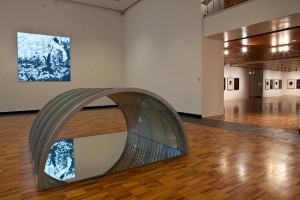
According to a 2003 book, there were 3.6 million Anderson Shelters in use during WWII. They must have been a common sight, as common as catching a glimpse of your parents having sex.
Mary Kelly, b.1941, has spoken of the War as a political ‘primal scene‘ for people of her generation. And so into this sculptural shelter are carved the wartime memories of eight of her contemporaries.
These are best read in the mirrored floor of the structure. So you have to get the angle right to read the lived experience of war, although they are no less real for that.
These memories have also punctured their stainless steel surrounds. Clearly these arrangements for protecting the next generation were only a partial success.
And because the whole piece is reflective, atrocities such as the Holocaust or Hiroshima may yet be written on our own faces, dress, comportment, whatever our age and distance from the war.
Witnessing this violence at whatever remove may lead to anger, confusion and a desire for revenge. If this was a Freudian case study, you could explain the events of May ’68 this way.
But you might also wonder about your own political primal scenes. These will depend on your age and location, but chances are you can remember the terrors of your own childhood shelter.
Habitus forms part of Mary Kelly: Projects, 1973-2010, which is on show at Whitworth Art Gallery, Manchester, until June 12. See gallery website for more details and read my review of the show on Culture24 here.
1 Comment
[…] This post was mentioned on Twitter by Corinna Spencer, Mark Sheerin. Mark Sheerin said: What's your political primal scene? Mary Kelly piece Habitus at Whitworth Gallery and on my blog: http://tinyurl.com/6c9qeyx […]